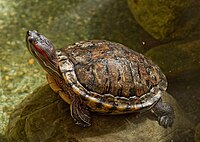
Photo from wikipedia
Aim: Invasive species are an ideal system for testing geographic differences in performance traits and measuring evolutionary responses as a species spreads across divergent climates and habitats. The European gypsy… Click to show full abstract
Aim: Invasive species are an ideal system for testing geographic differences in performance traits and measuring evolutionary responses as a species spreads across divergent climates and habitats. The European gypsy moth, Lymantria dispar dispar L. (Lepidoptera: Erebidae), is a generalist forest defoliator introduced to Medford, Massachusetts, USA in 1869. The invasion front extends from Minnesota to North Carolina and the ability of this species to adapt to local climate may contribute to its continuing spread. We evaluated the performance of populations along the climatic gradient of the invasion front to test for a relationship between climate and ecologically important performance traits. Methods: Insects from 14 populations across the US invasion front and interior of the invasive range were reared from hatch to adult emergence in six constant temperature treatments. The responses of survival, pupal mass, and larval development time were analyzed as a function of source climate (annual mean normal temperature), rearing temperature, and their interaction using multiple polynomial regression. Results: With the exception of female development time, there were no significant interactions between source climate and rearing temperature, indicating little divergence in the shape of thermal reaction norms among populations. Source population and rearing temperature were significant predictors of survival and pupal mass. Independent of rearing temperature, populations from warmer climates had lower survival than those from colder climates, but attained larger body size despite similar development times. Larval development time was dependent on rearing temperature, but there were not consistent relationships with source climate. Main Conclusions: Thermal adaptation can be an important factor shaping the spread of invasive species, particularly in the context of climate change. Our results suggest that L. d. dispar is highly plastic, but has undergone climate-related adaptation in thermal performance and life history traits as it spread across North America.
Journal Title: Journal of Biogeography
Year Published: 2020
Link to full text (if available)
Share on Social Media: Sign Up to like & get
recommendations!